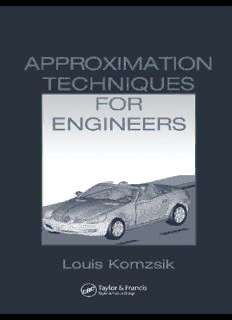Table Of ContentAPPROXIMATION
TECHNIQUES
for
ENGINEERS
APPROXIMATION
TECHNIQUES
FOR
ENGINEERS
Louis Komzsik
UGS Corp.
Cypress, California
Boca Raton London New York
CRC is an imprint of the Taylor & Francis Group,
an informa business
CRC Press
Taylor & Francis Group
6000 Broken Sound Parkway NW, Suite 300
Boca Raton, FL 33487-2742
© 2007 by Taylor & Francis Group, LLC
CRC Press is an imprint of Taylor & Francis Group, an Informa business
No claim to original U.S. Government works
Printed in the United States of America on acid-free paper
10 9 8 7 6 5 4 3 2 1
International Standard Book Number-10: 0-8493-9277-2 (Hardcover)
International Standard Book Number-13: 978-0-8493-9277-1 (Hardcover)
This book contains information obtained from authentic and highly regarded sources. Reprinted
material is quoted with permission, and sources are indicated. A wide variety of references are
listed. Reasonable efforts have been made to publish reliable data and information, but the author
and the publisher cannot assume responsibility for the validity of all materials or for the conse-
quences of their use.
No part of this book may be reprinted, reproduced, transmitted, or utilized in any form by any
electronic, mechanical, or other means, now known or hereafter invented, including photocopying,
microfilming, and recording, or in any information storage or retrieval system, without written
permission from the publishers.
For permission to photocopy or use material electronically from this work, please access www.
copyright.com (http://www.copyright.com/) or contact the Copyright Clearance Center, Inc. (CCC)
222 Rosewood Drive, Danvers, MA 01923, 978-750-8400. CCC is a not-for-profit organization that
provides licenses and registration for a variety of users. For organizations that have been granted a
photocopy license by the CCC, a separate system of payment has been arranged.
Trademark Notice: Product or corporate names may be trademarks or registered trademarks, and
are used only for identification and explanation without intent to infringe.
Visit the Taylor & Francis Web site at
http://www.taylorandfrancis.com
and the CRC Press Web site at
http://www.crcpress.com
T&F_LOC_A_Master.indd 1 6/14/06 9:32:47 AM
To my wife, Gabriella
Preface
This book is a collection of methods that provide an approximate result for
certain engineering computations. The di(cid:11)erence from the analytical result
(if such exists at all) occurs due to the formulation chosen to execute a com-
putation. As such, it must be distinguished from numerical errors occurring
due to the computational round-o(cid:11)errorof the (cid:12)nite precision of computers.
Thereisaperennialquestbymathematiciansandengineersto(cid:12)ndapprox-
imate results in two classes of problems. In one class, the input data may
only be given by a discrete set of points to describe the continuous geometry
of a physical phenomenon; however, a continuous function (cid:12)tting the data is
sought. Itisalsopossibleinthisclassthattheinputdataisgivenbyfunctions
thatneedtobeapproximatedbyanotherfunctionorsomediscretequantities
ofthefunctions(suchasderivativeatcertainpoint)arerequired. Intheother
class, usually a continuous problem is posed and an approximate solution at
a discrete set of points is desired, forpracticalreasonssuch as computational
cost.
Accordingly, the book is divided into two parts: data approximation tech-
niques and approximate solutions. The (cid:12)rst part starts with the classical
interpolation methods, followed by spline interpolations and least square ap-
proximations. It also covers various approximations of functions as well as
their numerical di(cid:11)erentiation and integration. The second part ranges from
the solution of algebraic equations, linear and nonlinear systems, through
eigenvalue problems to initial and boundary value problems. Both parts em-
phasize the logical thread and common principles of the approximationtech-
niques.
The book is intended to be an everyday tool as a reference book for prac-
ticing engineers, researchers and graduate engineering students. It is hoped
thatthe readerscansolveaparticularapproximationproblemarisingintheir
practice by directly focusing on a chapter or section describing the appropri-
ate techniques.
Louis Komzsik
vii
Acknowledgments
Iwouldliketothankmycoworker,Dr.LeonardHo(cid:11)nungofUGS forhiscare-
fulmathematicalproofreadingandveri(cid:12)cationofthecomputationalexamples
whilerepresentingasoftwareengineer’sperspective. Ialsoappreciatethecom-
mentsandrecommendationsofDr.JonathanHartofNorthrop-GrummanCor-
poration, whoalso veri(cid:12)edthe mathematical details andreadthe manuscript
with the eye of the application engineer.
Manythanksareduetothegreatsta(cid:11)ofTaylorandFrancisBooks. Specif-
ically, I would like to acknowledge the most enthusiastic support from Nora
Konopka, publisher and Helena Redshaw, manager. I am grateful for very
valuable corrections and contributions from Gloria Goss, proofreader and
Michael Davidson, editor.
Louis Komzsik
ThemodelinthecoverartisbycourtesyofDaimlerChryslerCorporation.
The rendering is intended to illustrate the wide-spread use of approximation
techniques. The engineering audience and the engineering applications are
represented by the car model. In addition, biological and environmental sci-
ences, depicted by the human and the road models, also frequently use the
approximation techniques of this book.
ix
Description:Approximation Techniques for Engineers provides a thorough and self-contained guide to the major techniques available for obtaining approximate solutions for problems arising in engineering. Demonstrating the techniques through numerous examples, algorithms, and applications, the book gives readers

